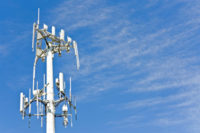OSHA issues new directive to keep communication tower workers safe
Communication towers are on the agency's regulatory agenda
 OSHA has updated its Communications Tower directive regarding the use of hoist systems used to move workers to and from workstations on communication towers. This follows an alarming increase in preventable injuries and fatalities at communication tower work sites.
OSHA has updated its Communications Tower directive regarding the use of hoist systems used to move workers to and from workstations on communication towers. This follows an alarming increase in preventable injuries and fatalities at communication tower work sites.
A disturbing trend
More fatalities occurred in this industry in 2013 than in the previous two years combined. This disturbing trend appears to be continuing, with nine worker deaths occurring so far in 2014.
"This directive ensures that communication tower workers are protected regardless of the type of the work they are doing on communication towers," said Dr. David Michaels, assistant secretary of labor for occupational safety and health. "Employers and cell tower owners and operators must make sure workers are properly trained and protected."
What the update covers
The directive outlines the proper use of hoist and other fall arrest systems and includes detailed information on how to hoist people safely. The directive updates a 2002 enforcement policy, which only covered the hoisting of workers to workstations during new tower erection activities. The updated policy covers any work on a communication tower - including both maintenance and new construction - that involves the use of a hoist to lift workers from one elevated workstation to another.
The release of the new directive is the latest in a series of actions OSHA has taken to improve cell tower safety. The agency is collaborating with the National Association of Tower Erectors and other industry stakeholders to ensure that every communication tower employer understands how to protect workers performing this high-hazard work.
Outreach efforts
OSHA sent a letter to communication tower employers urging compliance and strict adherence to safety standards and common-sense practices. OSHA has also created a new Web page targeting the issues surrounding communication tower work. This outreach follows a November 2013 memo to OSHA's compliance officers and regional administrators mandating increased attention, education and data collection on the industry. OSHA continues to investigate past incidents and will issue the results as they become available.
Communication towers are on the agency's regulatory agenda and OSHA expects to issue a Request for Information later this year.
Looking for a reprint of this article?
From high-res PDFs to custom plaques, order your copy today!








